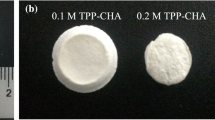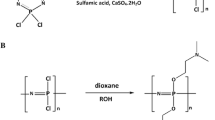Abstract
A biomimetic poly(propylene carbonate) (PPC) porous scaffold with nanofibrous chitosan network within macropores (PPC/CSNFs) for bone tissue engineering was fabricated by a dual solid–liquid phase separation technique. PPC scaffold with interconnected solid pore wall structure was prepared by the first phase separation, which showed a high porosity of 91.9% and a good compressive modulus of 14.2 ± 0.56 MPa, respectively. By the second phase separation, nanofibrous chitosan of 50–500 nm in diameter was formed in the macropores with little influence on the pore structure and the mechanical properties of PPC scaffold. The nanofibrous chitosan content was calculated to be 9.78% by elemental analysis. After incubation in SBF for 14 days, more apatite crystals were deposited on the pore surface as well as the nanofibrous chitosan surface of PPC/CSNFs scaffold compared with PPC scaffold. The in vitro culture of bone mesenchymal stem cells showed that PPC/CSNFs scaffold exhibited a better cell viability than PPC scaffold. After implantation in rabbits for 16 weeks, the defect was entirely repaired by PPC/CSNFs scaffold, as opposed to the incomplete healing for PPC scaffold. It indicated that PPC/CSNFs scaffold showed a faster in vivo osteogenesis rate than PPC scaffold. Hereby, PPC/CSNFs scaffold will be a potential candidate for bone tissue engineering.








Similar content being viewed by others
References
Langer R, Vacanti JP. Tissue engineering. Science. 1993;260:920–6.
Wang HN, Li YB, Zuo Y, Li JH, Ma SS, Cheng L. Biocompatibility and osteogenesis of biomimetic nano-hydroxyapatite/polyamide composite scaffolds for bone tissue engineering. Biomaterials. 2007;28:3338–48.
Ji Y, Ghosh K, Shu XZ, Li BQ, Sokolov JC, Prestwich GD, et al. Electrospun three-dimensional hyaluronic acid nanofibrous scaffolds. Biomaterials. 2006;27:3782–92.
Ma PX, Zhang RY. Synthetic nano-scale fibrous extracellular matrix. J Biomed Mater Res. 1999;46:60–72.
Liu XH, Ma PX. The nanofibrous architecture of poly(l-lactic acid)-based functional copolymers. Biomaterials. 2010;31:259–69.
Li XT, Zhang Y, Chen GQ. Nanofibrous polyhydroxyalkanoate matrices as cell growth supporting materials. Biomaterials. 2008;29:3720–8.
Liu XH, Ma PX. Phase separation, pore structure, and properties of nanofibrous gelatin scaffolds. Biomaterials. 2009;30:4094–103.
Wei GB, Ma PX. Macroporous and nanofibrous polymer scaffolds and polymer/bone-like apatite composite scaffolds generated by sugar spheres. J Biomed Mater Res A. 2006;78:306–15.
Liu XH, Smith LA, Hu J, Ma PX. Biomimetic nanofibrous gelatin/apatite composite scaffolds for bone tissue engineering. Biomaterials. 2009;30:2252–8.
Hay ED. Cell biology of extracellular matrix. 2nd ed. New York: Plenum Press; 1991.
Elsdale T, Bard J. Collagen substrata for studies on cell behavior. J Cell Biol. 1972;54:626–37.
Hasegawa S, Neo M, Tamura J, Fujibayashi S, Takemoto M, Shikinami Y, et al. In vivo evaluation of a porous hydroxyapatite/poly-dl-lactide composite for bone tissue engineering. J Biomed Mater Res A. 2007;81:930–8.
Kima SS, Park MS, Jeon O, Choi CY, Kim BS. Poly(lactide-co-glycolide)/hydroxyapatite composite scaffolds for bone tissue engineering. Biomaterials. 2006;27:1399–409.
Ren J, Zhao P, Ren TB, Gu SY, Pan KF. Poly(d,l-lactide)/nano-hydroxyapatite composite scaffolds for bone tissue engineering and biocompatibility evaluation. J Mater Sci Mater Med. 2008;19:1075–82.
Welle A, Kröger M, Döring M, Niederer K, Pindel E, Chronakis S. Electrospun aliphatic polycarbonates as tailored tissue scaffold materials. Biomaterials. 2007;28:2211–9.
Zhang L, Zheng ZH, Xi J, Gao Y, Ao Q, Gong YD, et al. Improved mechanical property and biocompatibility of poly(3-hydroxybutyrate-co-3-hydroxyhexanoate) for blood vessel tissue engineering by blending with poly(propylene carbonate). Eur Polym J. 2007;43:2975–86.
Zhang J, Qi HX, Wang HJ, Hu P, Ou LL, Guo SH, et al. Engineering of vascular grafts with genetically modified bone marrow mesenchymal stem cells on poly(propylene carbonate) graft. Artif Organs. 2006;30:898–905.
Lim SH, Hudson SM. Review of chitosan and its derivatives as antimicrobial agents and their uses as textile chemicals. J Macromol Sci Rev. 2003;C43:223–69.
Bhattarai N, Edmondson D, Veiseh O, Matsen FA, Zhang M. Electrospun chitosan-based nanofibers and their cellular compatibility. Biomaterials. 2005;26:6176–84.
Zeng R, Tu M, Liu HW, Zhao JH, Zha ZG, Zhou CR. Preparation, structure and drug release behaviour of chitosan-based nanofibres. IET Nanobiotechnol. 2009;3:8–13.
Yu YC, Roontga V, Daragan VA, Mayo KH, Tirrell M, Fields GB. Structure and dynamics of peptide-amphiphiles incorporating triple helical protein like molecular architecture. Biochemistry. 1999;38:1659–68.
Matthews JA, Wnek GE, Simpson DG, Bowlin GL. Electrospinning of collagen nanofibers. Biomacromolecules. 2002;3:232–8.
Zeng R, Tu M, Liu HW, Zhao JH, Zha ZG, Zhou CR. Preparation, structure, drug release and bioinspired mineralization of chitosan-based nanocomplexes for bone tissue engineering. Carbohyd Polym. 2009;78:107–11.
Li L, Hsieh YL. Chitosan bicomponent nanofibers and nanoporous fibers. Carbohyd Res. 2006;341:374–81.
Zhao JH, Han WQ, Chen HD, Tu M, Zeng R, Shi YF, Cha ZG, Zhou CR. Preparation, structure and crystallinity of chitosan nano-fibers by a solid-liquid phaseseparation technique. Carbohyd Polym. 2011;83:1541–6.
Ma ZW, Gao CY, Gong YH, Shen JC. Paraffin spheres as porogen to fabricate poly(l-Lactic acid) scaffolds with improved cytocompatibility for cartilage tissue engineering. J Biomed Mater Res B. 2003;67B:610–7.
Chen VJ, Ma PX. Nano-fibrous poly(l-lactic acid) scaffolds with interconnected spherical macropores. Biomaterials. 2004;25:2065–73.
Kokubo T.Formation of biologically active bone-like apatite on metals and polymers by a biomimetic process.Thermochim Acta. 1996; 280–281:479–90.
Jiang LY, Li YB, Wang JX, Zhang L, Wen JQ, Gong M. Preparation and properties of nano-hydroxyapatite/chitosan/carboxymethyl cellulose composite scaffold. Carbohyd Polym. 2008;74:680–4.
Chu XH, Shi XL, Feng ZQ, Gu ZZ, Ding YT. Chitosan nanofiber scaffold enhances hepatocyte adhesion and function. Biotechnol Lett. 2009;31:347–52.
Shin SY, Park HN, Kim KH, Lee MH, Choi YS, Park YJ, Lee YM, et al. Biological evaluation of chitosan nanofiber membrane for guided bone regeneration. J Periodontol. 2005;76:1778–84.
Kokubo T, Takadama H. How useful is SBF in predicting in vivo bone bioactivity? Biomaterials. 2006;27:2907–15.
Woo KM, Jun JH, Chen VJ, Seo J, Baek JH, Ryoo HM, Kim GS, Somerman MJ, Ma PX. Nano-fibrous scaffolding promotes osteoblast differentiation and biomineralization. Biomaterials. 2007;28:335–43.
Panda RN, Hsieh MF, Chung RJ, Chin TS. FTIR, XRD, SEM and solid state NMR investigations of carbonate-containing hydroxyapatite nano-particles synthesized by hydroxide-gel technique. J Phys Chem Solids. 2003;64:193–9.
Ma GP, Qian B, Yang JX, Hu CQ, Nie J. Synthesis and properties of photosensitive chitosan derivatives (1). Int J of Biol Macromol. 2010;46:558–61.
Zhao JH, Wang J, Tu M, Luo BH, Zhou CR. Improving the cell affinity of a poly(d,l-lactide) film modified by grafting collagen via a plasma technique. Biomed Mater. 2006;1:247–52.
Lao LH, Wang YJ, Zhu Y, Zhang YY, Gao CY. Poly(lactide-co-glycolide)/hydroxyapatite nanofibrous scaffolds fabricated by electrospinning for bone tissue engineering. J Mater Sci. 2011;22:1873–84.
Acknowledgments
The authors are grateful to Dr. Huantian Zhang’s kind help in the discussion of biological results analysis, and thankful to financial support from the National High Technology Research and Development Program of China (863 Program) (No. 2007AA09Z440) and the National Natural Science Foundation of China (No. 30900296).
Author information
Authors and Affiliations
Corresponding authors
Rights and permissions
About this article
Cite this article
Zhao, J., Han, W., Chen, H. et al. Fabrication and in vivo osteogenesis of biomimetic poly(propylene carbonate) scaffold with nanofibrous chitosan network in macropores for bone tissue engineering. J Mater Sci: Mater Med 23, 517–525 (2012). https://doi.org/10.1007/s10856-011-4468-3
Received:
Accepted:
Published:
Issue Date:
DOI: https://doi.org/10.1007/s10856-011-4468-3




